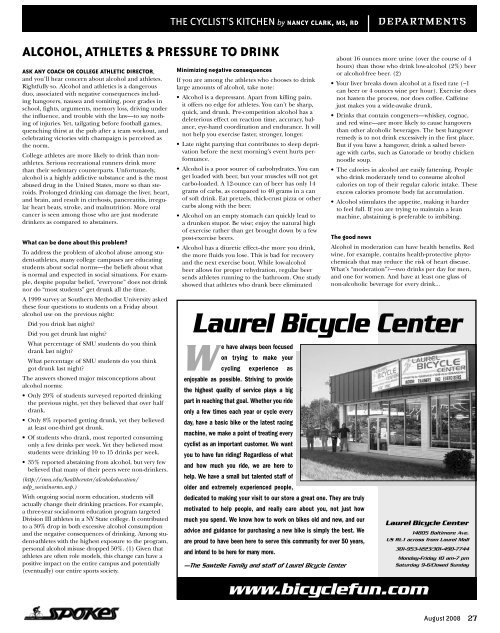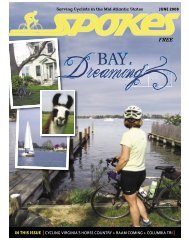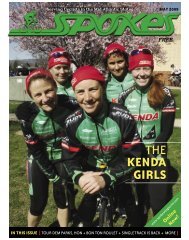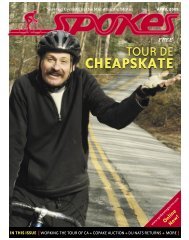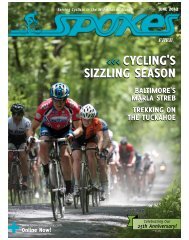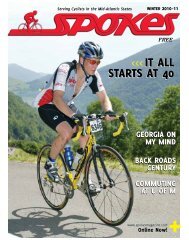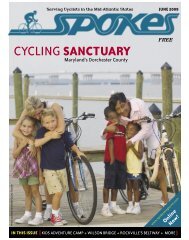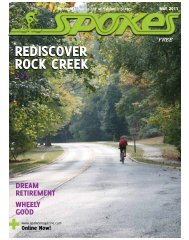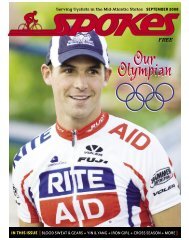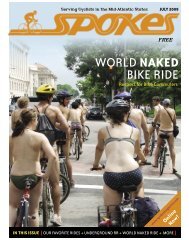IN THIS ISSUE [CYCLING CAROLINE COUNTY ... - Spokes Magazine
IN THIS ISSUE [CYCLING CAROLINE COUNTY ... - Spokes Magazine
IN THIS ISSUE [CYCLING CAROLINE COUNTY ... - Spokes Magazine
You also want an ePaper? Increase the reach of your titles
YUMPU automatically turns print PDFs into web optimized ePapers that Google loves.
THE CYCLIST'S KITCHEN by NANCY CLARK, MS, RD<br />
DEPARTMENTS<br />
ALCOHOL, ATHLETES & PRESSURE TO DR<strong>IN</strong>K<br />
ASK ANY COACH OR COLLEGE ATHLETIC DIRECTOR,<br />
and you’ll hear concern about alcohol and athletes.<br />
Rightfully so. Alcohol and athletics is a dangerous<br />
duo, associated with negative consequences including<br />
hangovers, nausea and vomiting, poor grades in<br />
school, fights, arguments, memory loss, driving under<br />
the influence, and trouble with the law—to say nothing<br />
of injuries. Yet, tailgating before football games,<br />
quenching thirst at the pub after a team workout, and<br />
celebrating victories with champaign is perceived as<br />
the norm.<br />
College athletes are more likely to drink than nonathletes.<br />
Serious recreational runners drink more<br />
than their sedentary counterparts. Unfortunately,<br />
alcohol is a highly addictive substance and is the most<br />
abused drug in the United States, more so than steroids.<br />
Prolonged drinking can damage the liver, heart,<br />
and brain, and result in cirrhosis, pancreatitis, irregular<br />
heart beats, stroke, and malnutrition. More oral<br />
cancer is seen among those who are just moderate<br />
drinkers as compared to abstainers.<br />
What can be done about this problem?<br />
To address the problem of alcohol abuse among student-athletes,<br />
many college campuses are educating<br />
students about social norms—the beliefs about what<br />
is normal and expected in social situations. For example,<br />
despite popular belief, “everyone” does not drink<br />
nor do “most students” get drunk all the time.<br />
A 1999 survey at Southern Methodist University asked<br />
these four questions to students on a Friday about<br />
alcohol use on the previous night:<br />
Did you drink last night?<br />
Did you get drunk last night?<br />
What percentage of SMU students do you think<br />
drank last night?<br />
What percentage of SMU students do you think<br />
got drunk last night?<br />
The answers showed major misconceptions about<br />
alcohol norms:<br />
• Only 20% of students surveyed reported drinking<br />
the previous night, yet they believed that over half<br />
drank.<br />
• Only 8% reported getting drunk, yet they believed<br />
at least one-third got drunk.<br />
• Of students who drank, most reported consuming<br />
only a few drinks per week. Yet they believed most<br />
students were drinking 10 to 15 drinks per week.<br />
• 35% reported abstaining from alcohol, but very few<br />
believed that many of their peers were non-drinkers.<br />
(http://smu.edu/healthcenter/alcoholeducation/<br />
adp_socialnorms.asp.)<br />
With ongoing social norm education, students will<br />
actually change their drinking practices. For example,<br />
a three-year social-norm education program targeted<br />
Division III athletes in a NY State college. It contributed<br />
to a 30% drop in both excessive alcohol consumption<br />
and the negative consequences of drinking. Among student-athletes<br />
with the highest exposure to the program,<br />
personal alcohol misuse dropped 50%. (1) Given that<br />
athletes are often role models, this change can have a<br />
positive impact on the entire campus and potentially<br />
(eventually) our entire sports society.<br />
Minimizing negative consequences<br />
If you are among the athletes who chooses to drink<br />
large amounts of alcohol, take note:<br />
• Alcohol is a depressant. Apart from killing pain,<br />
it offers no edge for athletes. You can’t be sharp,<br />
quick, and drunk. Pre-competition alcohol has a<br />
deleterious effect on reaction time, accuracy, balance,<br />
eye-hand coordination and endurance. It will<br />
not help you exercise faster, stronger, longer.<br />
• Late night partying that contributes to sleep deprivation<br />
before the next morning’s event hurts performance.<br />
• Alcohol is a poor source of carbohydrates. You can<br />
get loaded with beer, but your muscles will not get<br />
carbo-loaded. A 12-ounce can of beer has only 14<br />
grams of carbs, as compared to 40 grams in a can<br />
of soft drink. Eat pretzels, thick-crust pizza or other<br />
carbs along with the beer.<br />
• Alcohol on an empty stomach can quickly lead to<br />
a drunken stupor. Be wise; enjoy the natural high<br />
of exercise rather than get brought down by a few<br />
post-exercise beers.<br />
• Alcohol has a diuretic effect--the more you drink,<br />
the more fluids you lose. This is bad for recovery<br />
and the next exercise bout. While low-alcohol<br />
beer allows for proper rehydration, regular beer<br />
sends athletes running to the bathroom. One study<br />
showed that athletes who drank beer eliminated<br />
We have always been focused<br />
on trying to make your<br />
cycling experience as<br />
enjoyable as possible. Striving to provide<br />
the highest quality of service plays a big<br />
part in reaching that goal. Whether you ride<br />
only a few times each year or cycle every<br />
day, have a basic bike or the latest racing<br />
machine, we make a point of treating every<br />
cyclist as an important customer. We want<br />
you to have fun riding! Regardless of what<br />
and how much you ride, we are here to<br />
help. We have a small but talented staff of<br />
older and extremely experienced people,<br />
dedicated to making your visit to our store a great one. They are truly<br />
motivated to help people, and really care about you, not just how<br />
much you spend. We know how to work on bikes old and new, and our<br />
advice and guidance for purchasing a new bike is simply the best. We<br />
are proud to have been here to serve this community for over 50 years,<br />
and intend to be here for many more.<br />
—The Sawtelle Family and staff of Laurel Bicycle Center<br />
about 16 ounces more urine (over the course of 4<br />
hours) than those who drink low-alcohol (2%) beer<br />
or alcohol-free beer. (2)<br />
• Your liver breaks down alcohol at a fixed rate (~1<br />
can beer or 4 ounces wine per hour). Exercise does<br />
not hasten the process, nor does coffee. Caffeine<br />
just makes you a wide-awake drunk.<br />
• Drinks that contain congeners—whiskey, cognac,<br />
and red wine—are more likely to cause hangovers<br />
than other alcoholic beverages. The best hangover<br />
remedy is to not drink excessively in the first place.<br />
But if you have a hangover, drink a salted beverage<br />
with carbs, such as Gatorade or brothy chicken<br />
noodle soup.<br />
• The calories in alcohol are easily fattening. People<br />
who drink moderately tend to consume alcohol<br />
calories on top of their regular caloric intake. These<br />
excess calories promote body fat accumulation.<br />
• Alcohol stimulates the appetite, making it harder<br />
to feel full. If you are trying to maintain a lean<br />
machine, abstaining is preferable to imbibing.<br />
The good news<br />
Alcohol in moderation can have health benefits. Red<br />
wine, for example, contains health-protective phytochemicals<br />
that may reduce the risk of heart disease.<br />
What’s “moderation”?—two drinks per day for men,<br />
and one for women. And have at least one glass of<br />
non-alcoholic beverage for every drink...<br />
Laurel Bicycle Center<br />
Laurel Bicycle Center<br />
14805 Baltimore Ave.<br />
US Rt.1 across from Laurel Mall<br />
www.bicyclefun.com<br />
301-953-1223/301-490-7744<br />
Monday-Friday 10 am-7 pm<br />
Saturday 9-6/Closed Sunday<br />
August 2008<br />
27


